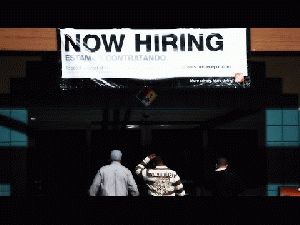Cross-posted from Yes! Magazine
It is difficult to overestimate the importance of unemployment in the distribution of income. In our new book, Getting Back to Full Employment (free download available), Jared Bernstein and I present evidence that a sustained one-percentage-point decline in the unemployment rate is associated with a 9.4 percent rise in the wages of workers in the bottom quintile of the wage distribution.
The logic behind this result is straightforward. When demand falls, employers don't lay off their managers and top executives; they lay off retail clerks, assembly line workers, and custodians. In periods of high unemployment, these workers have limited bargaining power. However when unemployment gets to low levels -- particularly like those we saw in the late 1990s boom -- employers find it difficult to get workers. They then bid up wages to attract new people into the workforce or to pull away workers from competitors.
There were numerous accounts in the business press in the late 1990s of employers going to extraordinary lengths to get additional workers. Some businesses chartered buses to take people from the inner cities to jobs in restaurants or hotels in the suburbs. Others arranged on-site child care or made arrangements to accommodate workers who needed to care for family members. Now, with the rate of unemployment still over 6 percent and an enormous amount of underemployment, employers feel little need to make extra efforts to find and retain workers.
In addition to producing upward pressure on wages, low rates of unemployment also allow for workers to put in more hours. Many workers, especially those on the bottom rungs of the economic ladder, are unable to work as many hours as they would like. The boom in the late 1990s led to an average increase of 17 percent in the hours worked by households in the bottom fifth of the income distribution.
While many may recognize that those at the bottom benefit greatly from low rates of unemployment, they may not recognize that the unemployment rate is to a large extent the result of policy decisions. There are three clear examples of such choices that directly affect the rate of unemployment.
First, the decision to push for a sharp reduction in the budget deficit when the 2009 stimulus package ran out led to slower growth and more unemployment. The logic is simple: When the government reduced its demand for goods and services, there was no offsetting increase in private-sector demand. The government cutbacks just meant less demand in the economy and, therefore, less employment. If the government spent more money on infrastructure, energy efficiency, health care, or education, it would create more demand and jobs. In short, low- and moderate-income people have been asked to pay a big price so that politicians could boast about lower budget deficits.
The second way in which high unemployment is a result of a deliberate decision is through the trade deficit. Currently, the United States has a trade deficit of nearly $500 billion a year (3 percent of GDP). Balanced trade would generate more than 4 million jobs directly and another 2 million jobs through the multiplier effect.
The main mechanism for bringing the trade deficit down is reducing the value of the dollar. A lower-valued dollar makes U.S. exports cheaper for people overseas, which means they will buy more of our exports. It also makes foreign goods more expensive for people in the United States, which will lead us to consume more domestically produced goods.
There are various ways the United States can bring about a lower-valued dollar, but the most obvious route is through direct negotiations with our trading partners -- exactly what the United States did in the mid-1980s. The result was an orderly reduction in the value of the dollar and a sharp fall in the size of the trade deficit.
Finally, we can decrease the unemployment rate through policies that reduce average work hours. One obvious policy is work sharing. This program, which 26 states already have in place as part of their state unemployment insurance (UI) systems, allows employers to cut back hours instead of laying off workers. Just as UI provides half pay for workers who have lost their jobs, work sharing allows workers to receive half their pay for the hours that were cut. This policy has been successfully used elsewhere, most notably in Germany where reductions in work hours are the main factor that explains its 5.1 percent unemployment rate.
There are also many policies that have supported growth of incomes at the top. For example, the implicit government guarantees to "too big to fail" banks amount to a subsidy of around $50 billion a year. Current corporate governance policy essentially allows CEOs to write their own paychecks. These and other policies need reforming to address the rise in inequality documented by Piketty. But boosting the living standards of low- and middle- income families through a policy of full employment is a very good place to start.






